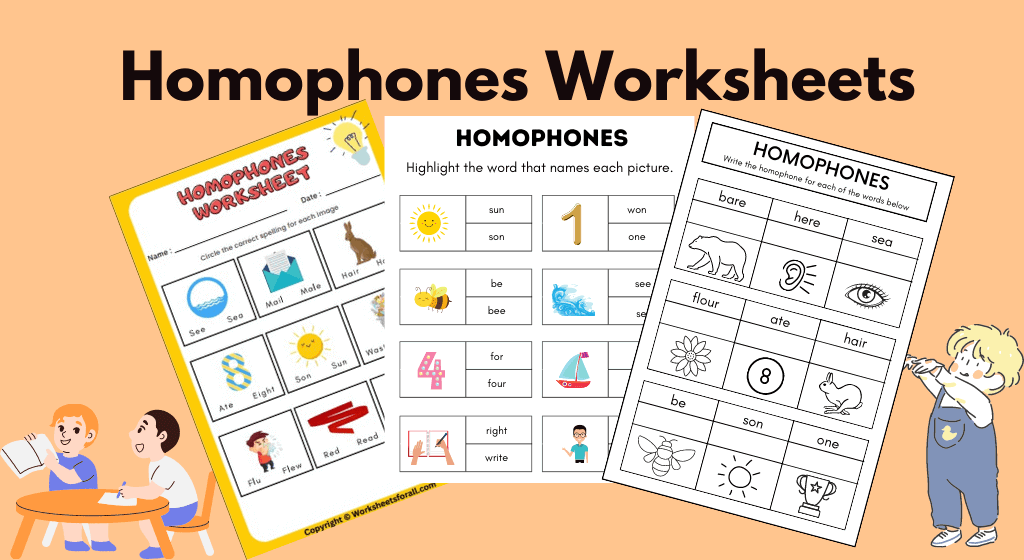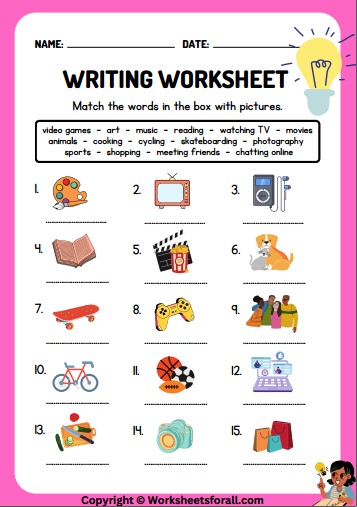Homophones Worksheet: Useful Way to Improve Spelling and Pronunciation
Updated: March 14, 2023
338

Homophones are words that sound the same but have different meanings and spellings. These can often be confusing for preschool children. That’s why the homophones worksheet is an effective tool for improving spelling and pronunciation. These homophones with picture worksheets are designed to help you differentiate between words that sound alike but have different meanings and to reinforce your knowledge of correct spelling and pronunciation.
Free Homophones Worksheets For Download
Introduction: What Is Homophone Definition?
Homophones are a type of word that sound similar but have different meanings and spellings. They can be tricky for anyone, regardless of their age or level of education. Homophones are often confused with one another, which can lead to spelling errors and misunderstandings in communication.
For instance, ‘there’ and ‘their’ sound the same but have different meanings. Similarly, ‘to’, ‘too’, and ‘two’ sound the same but have different spellings and meanings. Understanding homophones and being able to use them correctly can significantly enhance your spelling and pronunciation skills.
Homophones are commonly used in everyday communication, whether it be in writing or speech. Being able to distinguish between them and use them appropriately can help improve your overall communication skills.
The Importance of Understanding Homophones in Spelling and Pronunciation by Homophones Worksheet
Knowing the difference between homophones can help you avoid common spelling mistakes, such as using “there” instead of “their” or “two” instead of “too.” Additionally, understanding homophones can improve your pronunciation skills, which is essential for effective communication. Proper pronunciation can also impact how others perceive your level of education and professionalism.
Furthermore, understanding homophones can also improve your comprehension skills when listening to others. Being able to differentiate between similar-sounding words can prevent misunderstandings and help you follow conversations more accurately.
Overall, understanding homophones is an important aspect of language learning that can enhance both written and spoken communication skills. By improving your knowledge of homophones, you can become a more effective communicator and avoid common mistakes in spelling and pronunciation.
Examples of Homophones and Definitions
Some examples of homophones include “to”, “two”, and “too”; “there”, “their”, and “they’re”; “wear” and “where”; “flower” and “flour”; and “write” and “right”. Understanding the definitions of these words and their proper usage can help improve your writing and communication skills.
For instance, “to” is a preposition used to indicate direction or movement, while “two” is a number, and “too” means “also” or “excessively”. Similarly, “there” is an adverb used to indicate a location, “their” is a possessive pronoun indicating ownership, and “they’re” is a contraction for “they are”. Knowing the difference between these homophones can help you avoid common mistakes in writing and speaking.
By using homophones with picture worksheets, you can practice identifying and using these words correctly, which will improve your spelling and pronunciation skills. we have many homophones worksheets in which homophones write right worksheets is one which is considered as the most useful worksheet.
Using Homophones Worksheet for Practice and Mastery
Homophones worksheets are an excellent tool for learners to practice and master the use of homophones. These worksheets typically include exercises that challenge learners to identify and differentiate between homophones, spell them correctly, and use them in sentences.
Using homophones worksheets regularly can help learners improve their spelling and pronunciation skills, as well as their ability to communicate effectively in writing. Moreover, worksheets offer learners an opportunity to practice independently, allowing them to work at their own pace and focus on their specific areas of weakness.
To use homophones worksheets effectively, learners should begin by reviewing the definitions of the homophones they will be practicing. They should then complete the exercises in a quiet, distraction-free environment, taking care to read each sentence carefully and think critically about the homophone being used.
It is also essential to review the answers and understand any mistakes made to avoid repeating them in the future. Using homophones worksheets consistently and tracking progress can help learners build their skills over time and become confident in their ability to use homophones accurately.
Strategies for Differentiating Between Homophones
Differentiating between homophones can be challenging, but there are a few strategies that can help improve your understanding and usage of these words. One approach is to pay close attention to context. Often, homophones will have different meanings depending on the context in which they are used. For example, the homophones “bare” and “bear” have different meanings – the former refers to something that is uncovered or naked, while the latter refers to a large carnivorous mammal. By paying attention to the context of the sentence, you can more easily determine which homophone is the correct choice.
Another strategy is to practice using homophones in sentences. Homophone worksheets can be a helpful tool for this. By practicing using homophones in context, you can gain a better understanding of how to differentiate between them. Additionally, it may be helpful to study the spellings and definitions of commonly confused homophones. By familiarizing yourself with the differences between these words, you can improve your ability to use them correctly.
Lastly, if you’re still having difficulty with homophones, consider seeking help from a teacher or tutor. They can provide additional guidance and support to help you improve your understanding and usage of homophones. With practice and support, you can master the art of differentiating between homophones and improve your spelling and pronunciation skills.
Common Mistakes to Avoid When Using Homophones Worksheet
When using homophones worksheets, there are some common mistakes that you should avoid to make the most out of your practice. One of the most common mistakes is not paying attention to the context in which the homophones are used. Homophones have different meanings, and their context can help you determine which one to use.
Another mistake to avoid is relying solely on the worksheet and not practicing outside of it. Worksheets are a great tool for practice, but it’s essential to apply what you learn in other contexts, such as writing or speaking.
Furthermore, another common mistake is not reviewing your mistakes and understanding why you made them. It’s crucial to identify your mistakes and learn from them to avoid making the same mistake again in the future.
Lastly, rushing through the worksheets and not taking the time to thoroughly understand the material is another mistake to avoid. Take your time to read and understand the homophones and their meanings, and make sure you’re using them correctly in practice.
By avoiding these common mistakes, you can ensure that you’re making the most out of your homophones worksheets and improving your spelling and pronunciation skills effectively.
Tracking Your Progress: Measuring Improvement in Spelling and Pronunciation
Improving your spelling and pronunciation skills can take time and effort, but using homophones worksheets can be an effective tool for tracking your progress. By regularly practicing with these worksheets, you can measure your improvement and identify areas where you need more practice.
One way to track your progress is to keep a record of your scores on the worksheets. You can also note the homophones that you struggled with and review them again to reinforce your understanding.
Another strategy is to compare your pronunciation and spelling of homophones over time. Record yourself reading a list of homophones at the beginning of your practice, and then record yourself again after several weeks or months of practice. This can help you see the improvements in your pronunciation and spelling skills.
It’s also important to challenge yourself by using more difficult homophones as you improve. This can help you further develop your skills and ensure that you continue to progress.
Overall, by tracking your progress and regularly practicing with homophones worksheets, you can effectively improve your spelling and pronunciation skills.
Next Steps: Using Homophones Worksheet for Continued Learning and Growth
Homophones worksheets can be an excellent tool for improving spelling and pronunciation skills. However, it’s essential to use them effectively to get the most out of your practice. Now that you have a good understanding of what homophones are, why they’re important, and how to differentiate between them, it’s time to take the next steps in your learning journey.
One of the most critical things to do when using homophones worksheets is to track your progress. Keep a record of the homophones you struggle with the most and make a point of practicing them regularly. By doing this, you’ll be able to see how much you’ve improved over time, which can be incredibly motivating.
Another essential step is to continue practicing regularly. Don’t just use homophones worksheets as a one-time thing. Make them a part of your regular practice routine to ensure continued learning and growth.
Additionally, consider seeking out additional resources to supplement your learning. Online resources, books, and even audiobooks can be helpful in improving your understanding of homophones and how to use them correctly.
In summary, using homophones worksheets can be an effective way to improve your spelling and pronunciation skills. By tracking your progress, continuing to practice regularly, and seeking out additional resources, you can continue to learn and grow in your language abilities.
FAQS
How may homophones are there in the world
It is difficult to determine exactly how many homophones there are in the world as new words and variations are constantly being created and adopted into different languages. Additionally, different languages have different phonetic structures and rules which can affect the number of homophones that exist within them.
Give 15 examples of homphones
- hear (to perceive sound) and here (in this place)
- to (preposition indicating motion towards a destination) and too (also or excessively)
- bear (a large mammal) and bare (naked)
- flower (a plant with blooms) and flour (powder made from ground grains)
- allowed (permitted) and aloud (out loud)
- knight (a medieval soldier) and night (the time when it is dark outside)
- son (a male child) and sun (the star that lights our world)
- right (correct or direction) and write (to record words)
- meet (to come together) and meat (flesh used as food)
- sale (discounted price) and sail (to travel by boat)
- road (a pathway for vehicles) and rode (past tense of ride)
- there (in that place) and their (belonging to them)
- be (to exist) and bee (a flying insect)
- peace (calmness or tranquility) and piece (a part or segment of something)
- sea (large body of saltwater) and see (to perceive visually)

Please Write Your Comments